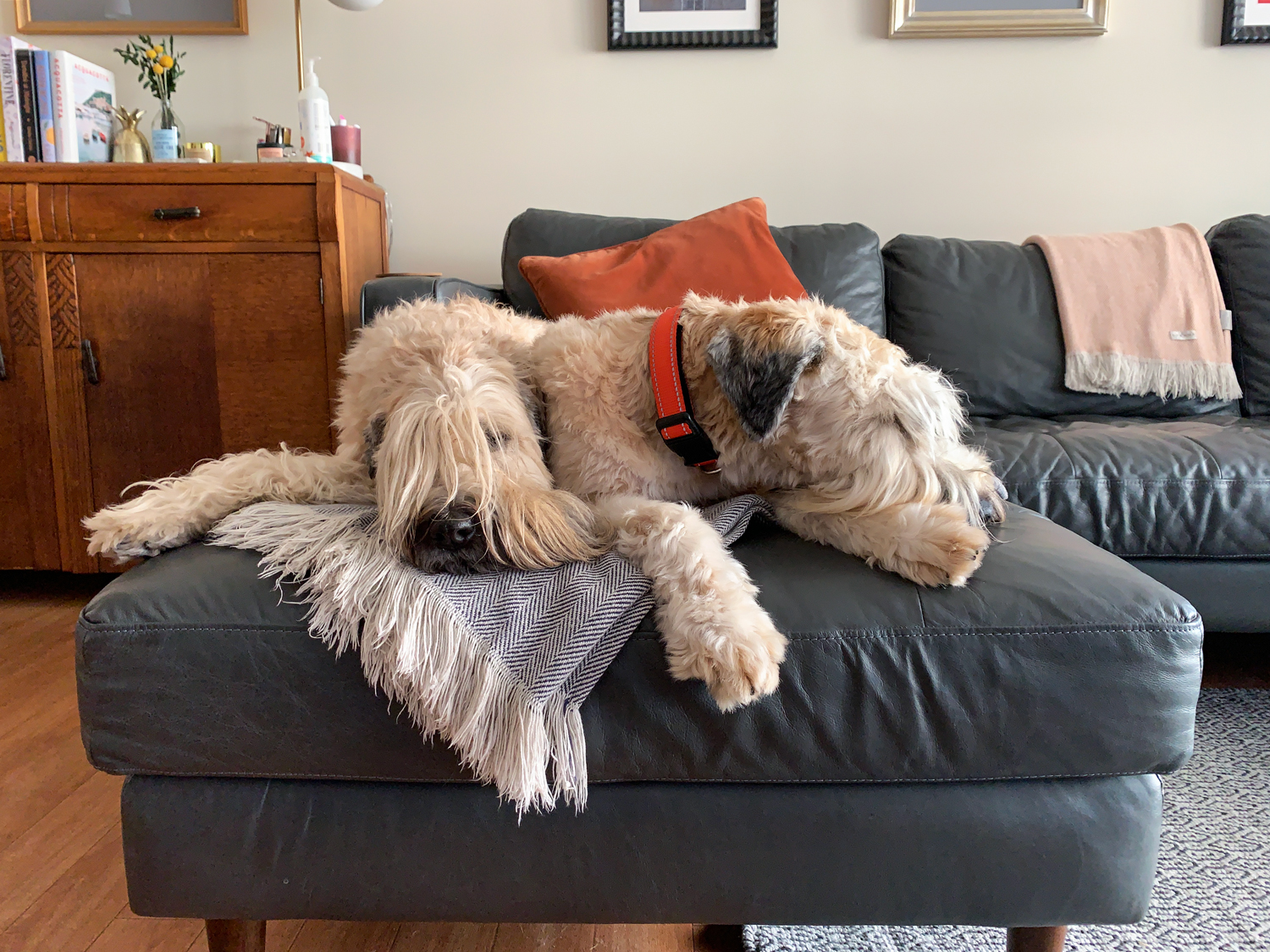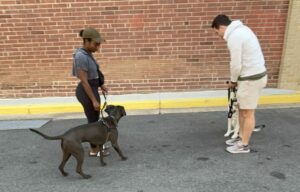This post is written by Alyse Stokes, a freelance writer and longtime partner of District Dogs. The seven-part series will follow her new rescue pup, Nash, as he moves through District Dogs’ six-week Adult Basics training course. Posts will cover each week of the training program plus a follow-up post a few weeks after graduation to see how Nash is doing with his training outside of class.
Bringing a new dog into your home is an exciting and fun prospect. But whether you’re bringing home a young puppy or adopting an older dog, there is an inevitable period of adjustment ahead—for you and your pup. As rewarding as it is, rehoming a rescue dog can present even more challenges than raising a young puppy since you often have little to no information about your new furry friend’s training background. You may soon find yourself bumping up against your dog’s old habits and fears while also trying to help your pup get to know you and your home.
I found myself in this exact situation in January 2021 when my husband and I adopted a ten-month old Wheaten Terrier named Nash. Having spent my entire life around dogs and already owning a seven-year-old Wheaten terrier, I felt confident that I was ready for the challenge of bringing Nash into our house. Additionally, I worked for District Dogs as a dog walker several years ago, and I partner with them in my current job as a writer to produce content for the DD website and blog. Basically, I went into the rescue experience thinking “I got this.”
However, Nash quickly put me in my place! He reminded me that every dog parent—regardless of their experience level—needs a solid support system and that knowing when to get professional help is a virtue.
About Nash
Nash is an eleven-month-old male Wheaten Terrier who we adopted through MASTER, a local terrier rescue organization. He came to the rescue after his original family surrendered him to a county shelter because he was behaving aggressively with their older dog. He entered rescue underweight and with severe matting of his coat. Thankfully, our rescue director worked tirelessly to rehab him, getting him groomed and getting his weight up nearly 20% during his time with her.
She also worked to socialize him with her own dogs, realizing that his main issue wasn’t one of aggression so much as an abundance of energy combined with poor early socialization. He had received little or no training in his original home. Nash had the classic exuberance of a Wheaten Terrier puppy with no real ability to control or manage his impulses. What this meant for us was a sweet, goofy, and friendly boy who desperately wants to please us and to be friends with every other dog he meets. However, he struggles to greet and play in a way that other dogs respond to, coming on too strong and not always understanding dog social cues.
Despite my early confidence that I had the background to manage his transition into our house on my own, I soon realized Nash needed a more formalized training experience. The pandemic means that my husband and I both work from home now. Two humans and two dogs are a lot in a sub-900 square foot apartment—especially when one dog has an inexhaustible supply of energy. My husband and I found ourselves trading off “Nash Watch” duties and mostly spent that time saying “no” while trying to keep him from chewing on shoes, clothes, bedding, or our other dog.
Our older dog, Molly, is a sweet and submissive girl who is patient with her new baby brother… but maybe a little too patient. She isn’t good at setting boundaries with him, and that means he tends to play too rough with her. I knew I needed to get Nash socialized in an environment that offered more structure than we could provide at home.
About Adult Basics
Having written about the different dog training options at District Dogs before, I was sure they would have the right solution for me: a group dog training class guided by a professional trainer. Nash’s age and size made him a poor candidate for puppy kindergarten, but Adult Basics looked like the perfect fit.
Designed for older dogs who need a refresher course on lessons from puppy class or for recent rescues who are starting training for the first time, this class offers professional guidance in building the foundations of good dog behavior. Crucially, Adult Basics also offers the opportunity for socialization. From working on leashed greetings to allowing some off leash play time each session, District Dogs’ Adult Basics class was an ideal fit for a recent rescue struggling to master dog social cues.
Week One: In the Classroom
The first session of Adult Basics is humans-only. That might sound unusual, but I cannot stress how valuable it was to get information about the overall structure and plan for our class, the equipment we would need for classes, and to cover the training methodology WITHOUT having to wrangle Nash into sitting calmly for an hour.
This first dog-free session was also a chance for our trainer, Carissa, to gather information about each of the dogs in our group, get the lowdown on the things we as owners were struggling with at home, and to give helpful advice on setting our dogs up for success in their training sessions to come. She walked our group through some of the evidence-based dog psychology that would guide our training plans. This information was a great reminder of how clear and consistent training isn’t just about making our lives easier; it’s also the kindest and best way to help Nash adjust to his new environment.
One focus of Carissa’s breakdown that particularly resonated with me is how our dogs aren’t really equipped to grasp negative concepts. Basically, dogs do well when we give them a job to do. But it’s a lot harder for their brains to grasp and follow rules that are built around what not to do.
Practically, this means the amount of time my husband and I spent saying “No” to Nash wasn’t really teaching him how to behave. Instead, our goal moving forward would be to redirect his energy into desirable behaviors. For example, instead of simply saying “No” to Nash when he decides it’s time to chew on a shoe or an article of clothing, our new strategy is to remove the item from him and hand him a chew toy. When he engages by taking the toy, he gets lots of praise and attention. This teaches him that playing with his toys is a desirable behavior. Failing to make a big fuss about the item he’s not supposed to chew on avoids any misinformation he might get from our negative attention.
Another helpful bit of homework Carissa gave us was to notice and reward Nash he was being a good dog. During a training journey, it can be easy to get stuck only seeing “bad” behaviors in your dog. This can cause you to lose sight of what a sweet and good dog they really are, and it often means your dog only gets attention during training exercises or when behaving badly. Carissa challenged the pet parents in our group to put 15-20 small treats in a dish each morning, with the goal of giving all those treats to our dogs through the course of a day. They could be given for something simple like laying calmly while we eat dinner, playing nicely with a toy, or when our dog looks up and “checks in” with us on a walk.
Finally, I found it especially helpful to hear from other pet parents that their pups—who ranged from recent rescues to older puppies—needed help with some of the same issues we saw with Nash. Aside from the advice of a professional trainer, group dog training offers a sense of community for pet parents. Sometimes we think we have a uniquely challenging dog when we actually have a perfectly normal dog who is dealing with behavior challenges that are extremely common.
Week One: At Home
Aside from giving Nash less negative attention and rewarding him for good behaviors, another piece of homework was priming him for some of our upcoming classroom work. This involved teaching him to associate a specific word or phrase with tangible rewards… aka treats! I’m certain this was Nash’s favorite part of homework. What pup wouldn’t enjoy having your human hand you ten treats in a row and say, “Yes! Good Boy!” each time? By the time we were 24 hours away from our second class, I knew the priming was working when I said “Yes! Good Boy!” on a walk and he immediately turned to me expecting his treat.
Carissa also gave us some helpful tips on creating a solid and consistent potty routine for Nash, since he was still struggling with occasional accidents in the house. He got the hang of this quickly—a huge source of relief. If you’ve ever wandered your neighborhood for what feels like eternity waiting for your dog to go to the bathroom, then you understand the appeal of being able to get your pup to potty almost as soon as you leave the house. This bit of training also made it easy for my husband to make sure Nash goes potty first when he takes him out for a run. Ultimately, it reduced the mid-run disruptions to just one quick pit-stop, down from two or three long sniffing/potty breaks.
Heading into our second class, I feel the first week of work was a success in priming Nash to listen to me (I have treats!) and in helping my husband and I become more consistent with our messages to Nash. I also found the daily “good dog treats” we gave out through the week a nice reminder of all the reasons we wanted to adopt him in the first place: he’s a sweet and goofy boy who we absolutely adore. I can’t wait to see what Week Two holds and to share the progress we’re all making in our journey to building a solid foundation with Nash.



